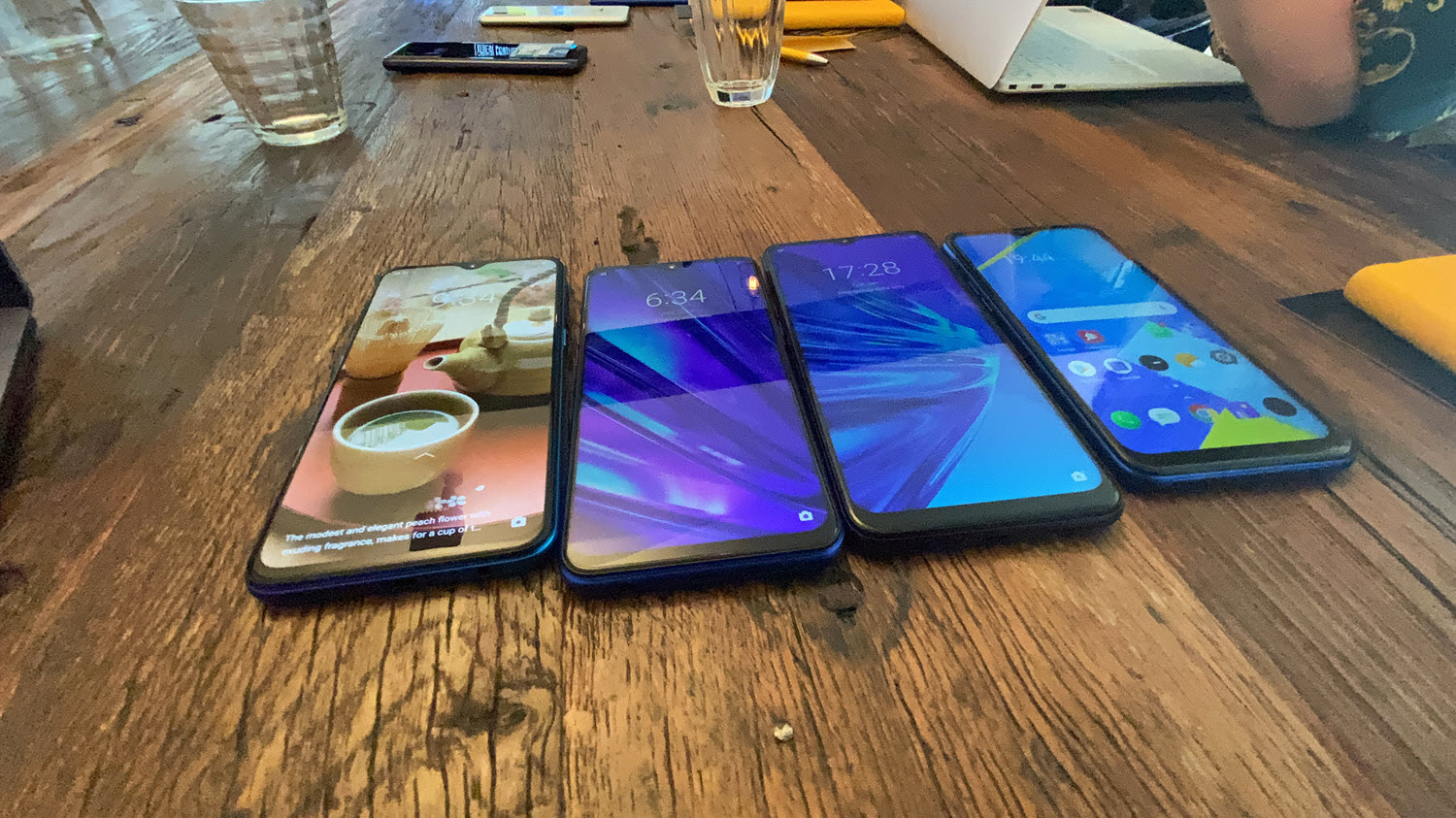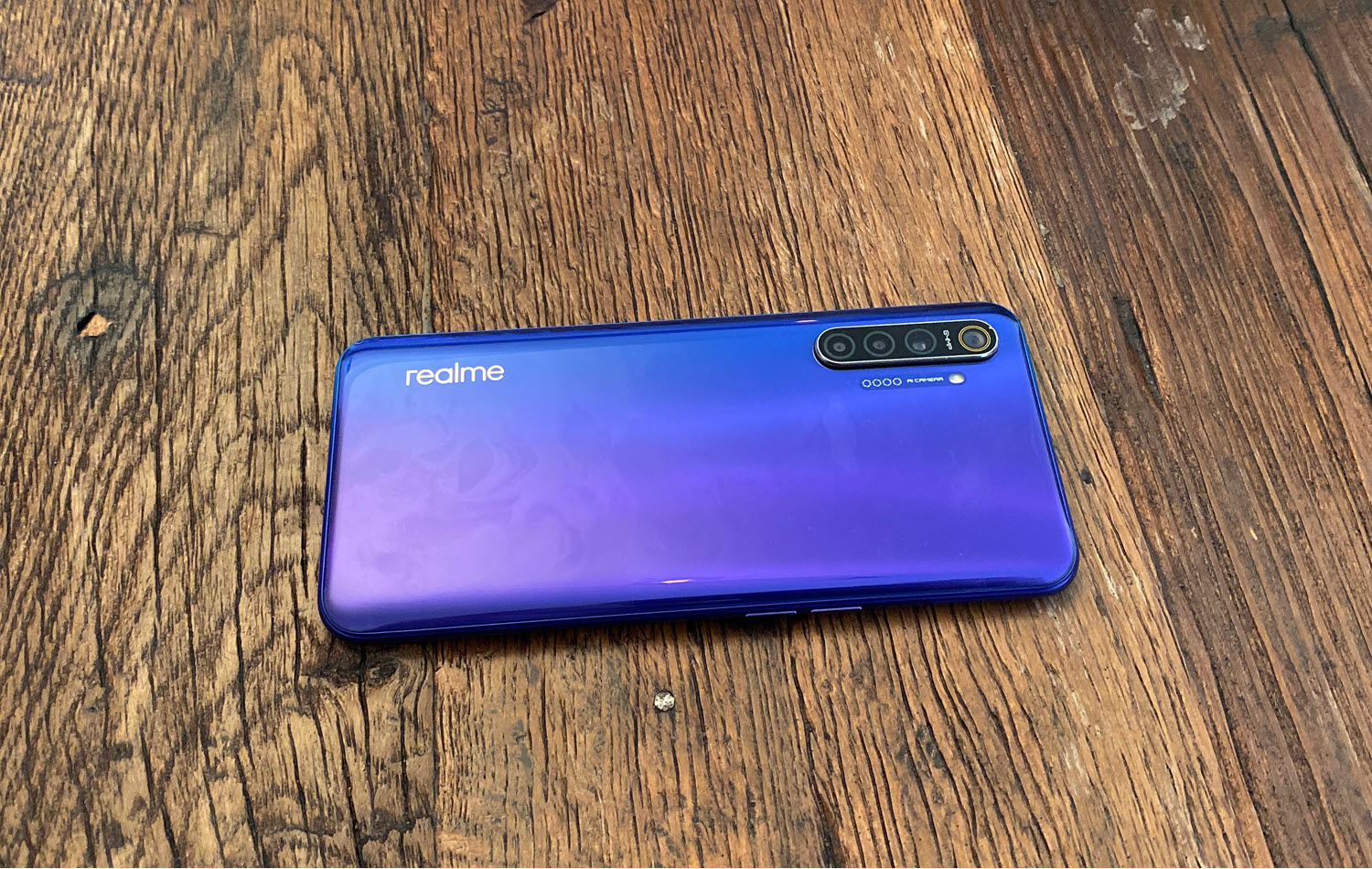Realme’s promise is stylish and powerful camera phones at a fraction of flagship price, which sounds awfully familiar to another big Chinese phone OEM.
There’s a reason for that, as it turns out. Prior to Realme’s official Australian launch this evening, I had the opportunity for some hands-on time with Realme’s four phone offerings coming to the Australian market.
In ascending order of price, they’re the $199 Realme C2, the $299 Realme 5, the $399 Realme 5 Pro and the effective “flagship” device, the $499 Realme XT.

The first thing you’ll notice when you power up any of them is that they’re not running stock Android, but instead ColorOS, which you’d be familiar with if you’ve ever used any of Oppo’s wide range of phones.
The relationship between Oppo and Realme is… well, as they say in the modern age, it’s complicated.
The president of Realme is a former vice president of Oppo, the brand at one time distinctly was an Oppo sub-brand, and it uses Oppo’s Android launcher, its VOOC fast charging system and many of the same factories.
While Realme insists that it’s a fully separate company now, the reality is that it’s yet another brand under the BBK Electronics umbrella, alongside Oppo and OnePlus offering up phones with a strong camera focus.
Where OnePlus has purely played in the premium pool, and Oppo’s pricing has trended upwards, those price points put Realme very solidly in the budget to mid-range space only, at least at launch. So what do you get for your money?
The flagship Realme XT has a 6.1 inch 1080×2340 FHD+ Super AMOLED display with a front teardrop notch. It’ll ship in two colours, Pearl White and Pearl Blue, and if I had to describe the latter, the phrase “Twilight” would probably escape my lips at some point. Then again, I’m a sucker for blue phones, and looking like Huawei’s own tones might be derivative, but it’s also kind of nice.
The Realme XT’s core specifications are decent within its price range, with a Snapdragon 712 processor, 8GB RAM and 128GB of onboard storage, expandable via microSD storage. One interesting point of differentiation here is that it’s one of that very rare breed of handsets that supports a triple bay slot, so you can have both dual SIM and microSD expansion at the same time, rather than sacrificing storage for a second SIM or vice versa.
Still, the Realme XT’s calling card is its quad-camera setup, with a primary 64MP lens, 8MP wide angle, 2MP portrait and 2MP macro lens. As with most mid-range and budget phones, you’re never really addressing those sensors individually, and there’s a fair bit of pixel crunching going on for most shots.
While I could only really test around the room, it seemed fair for what it was, but I’d need more real testing time. It’s not worth getting entirely hung up just on a big megapixel number for a phone, though. Actual shot quality is considerably more complex than that.
Switching down the ranks you find the $399 Realme 5 Pro and $299 Realme 5. There’s an odd mix of specifications at play here, because the cheaper Realme 5 has a larger display (6.5 inch, 720×1600) and a bigger battery (5000mAh) than the supposedly “Pro” version, which runs with a 6.3 inch display and a 4035mAh battery.
However the display on the Realme 5 Pro is sharper at 2340×1080, and its running on a Snapdragon 712 with 8GB of RAM compared to the Snapdragon 665 and 4GB of RAM found in the vanilla version. Of course there are also some solid camera differences in play too. The Realme 5 Pro runs with a 48MP primary, 8MP wide, 2MP portrait and 2MP macro lens — so it’s basically the stepped down XT — where the Realme 5 has a 12MP primary, 8MP wide and the same 2MP paired portrait and macro lens set.
Still, when you consider that it wasn’t that long ago that dual lenses were the exclusive province of premium priced phones, it shows how far we’ve come. Again, I don’t want to put much of a verdict on their camera chops down just yet, because there wasn’t enough time to really stress them, or for that matter take away camera samples.
However if you are keen on the core specifications, it’s worth knowing that they’re using the same very simple camera app as you’ll find on Oppo’s phones, which means you’re not awash in shooting modes or fancy effects. It was also pretty noticeable as I stepped down the range that the camera app tended to lag a touch switching modes.

The baby of the Realme family is the entirely affordable Realme C2 at $199. It’s arguably Realme’s best “value” phone when you look at what you can otherwise get for that kind of price. Sure, you dip down to a Mediatek Helio P22 with just 3GB of RAM and 64GB of onboard storage, but it’s also rocking a 4,000mAh battery, a 6.1 inch 1560×720 pixel display and a choice of either “Diamond Blue” or “Diamond Black” finishes. I’ve certainly seen less appealing looking phones at this kind of price point.
All of Realme’s phones will launch in Australia with Android 9 Pie on board, which is a little disappointing in an age of Android 10, although not unusual for the budget market. Here again Realme is almost certainly stymied by the fact that it’s reliant on Oppo for ColorOS, so it’ll probably be a while before Android 10 updates roll through, if indeed they do.
I asked Realme Australia’s local MD Andy Yang about whether Realme’s “independent” status from Oppo would allow it to release either security or full version updates of Android ahead of Oppo, and he told me that they would be releasing at “around” the same time as Oppo.
It’s a tricky business launching a new phone brand in Australia, and even moreso one that targets the more affordable end of the market. With established players like Alcatel, Nokia, Samsung, Motorola, Huawei and even other more recent entrants such as Xiaomi, or Mintt already present, there’s plenty of competition.
Realme is only going to sell via online outlets, including JB HiFi, The Good Guys, Bing Lee, eBay, Amazon, Kogan, Catch and Mobileciti. It will also launch its own online store to sell its phone products locally. When asked about possible pop-up or “experience” style stores, Realme MD Andy Yang was non-committal, noting that the first stage strategy for the company would be online sales only.
The flagship Realme XT will go on sale in Australia first on the 22nd of October, followed by the Realme 5 on the 25th, and then the Realme 5 Pro and Realme C2 on the 30th of October.







Nice review thanks – and the camera combo’s sound great – but mostly I enjoyed the line “I’m a sucker for blue phones” 🙂
looks lite not supporting full LTE bands required for Aus network.
https://www.realme.com/au/#
I was about to ask this… Can you guys over at Ausdroid find out what the deal is with the lack of Band 28 support on all their phones? Is it simply a copy/paste or typo error to the Aussie website because these devices in Europe do support Band 28…
For example the Realme 5 Pro on the Realme EU website lists the following bands.
GSM: 850/900/1800/1900MHz
WCDMA: 850/900/2100MHz
FDD-LTE: Bands 1/3/5/7/8/20/28
TD-LTE: Bands 38/40/41(2535-2655MHz)
Where as the Realme AU website lists the following…
GSM: 850/900/1800/1900MHz
WCDMA: 850/900/2100MHz
FDD-LTE: Bands 1/3/5/8
TD-LTE: Bands 38/40/41(2535-2655MHz)
Please let us know also, cause its a big issue to Optus owners. Thanks.
I have contacted Realme AU and the correct bands are now listed on their website.
Their phones cover all the bands used by our carriers including band 28 so the initial details were incorrect thankfully.
The lack of NFC though is a disappointment and it should have been included at least on the higher spec phones.
Cheers
Realme have corrected the specs on their website, and all models support all our LTE bands in Australia.
Ausdroid, are we going to see some reviews of these devices from you guys? 😉
Cheers
Not sure at this stage. We don’t have review devices at the moment.